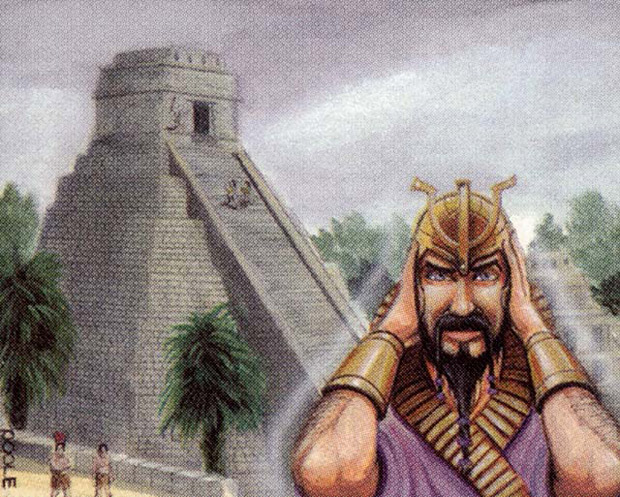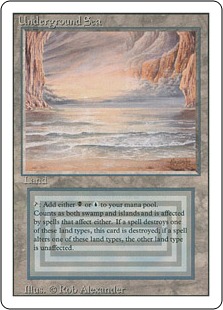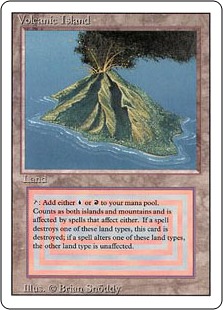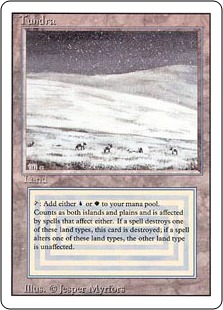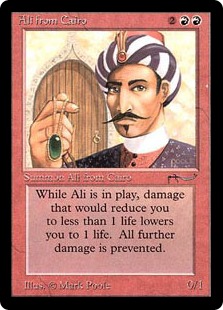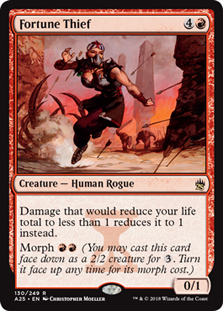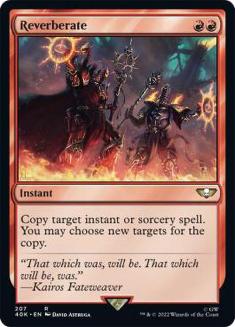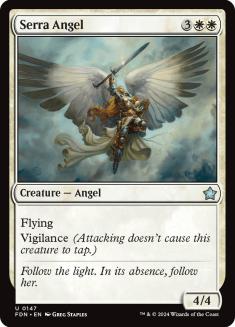Disclaimer: If you are a Wizards of the Coast (WotC) employee, I give you free-and-clear permission to use any of the ideas I publish in this article without any need for compensation.
The Reserved List. Oh, the Reserved List. I’ve been asked more about the Reserved List over the years than any other Magic topic. “Should WotC get rid of the Reserved List?” they ask. “Promissory estoppel!” they yell, from rooftops too high to be seen. I’ve written about the Reserved List so, so many times.
I’ve also been interviewed about the Reserved List by Katie Bates of Hipsters of the Coast back in 2018.
For this week, I’m going to tilt at windmills once again. WotC has made it abundantly clear that the Reserved List isn’t being touched.
I, and other people, have said pretty much everything that can be said about the Reserved List. For instance, check out Scott Peitzer’s deep dive into promissory estoppel and Saffron Olive’s look at the Reserved List as per value of cards.
I’m writing this article because I feel that I’ve found a way to remove the Reserved List, while addressing all of the issues that people have previously brought up with the Reserved List. And no, before you ask, it’s not “buy WotC from Hasbro and change the policy” as someone once suggested to me on Twitter.
Some Facts About the Reserved List
- WotC discontinued adding cards to the Reserved List as of Mercadian Masques in 1999. This is over twenty years ago.
- The Reserved List is not immutable. WotC changed the Reserved List policy at least once before, in 2002 (you can learn more about that here and here).
- The reprinting of key cards in From the Vault: Relics and Duel Deck: Phyrexia vs. the Coalition led to the latest round of outcry against removing the Reserved List. This happened in 2010 (you can learn more about that here).
- Previous to those cards, several Reserved List cards had already been reprinted as Promotional Cards. These include:
- Gaea’s Cradle (Judge Foil, 1998)
- Intuition (Judge Foil, 2003)
- Phyrexian Negator (JudgeFoil, 2004)
- Deranged Hermit (Judge Foil, 2004)
- Yawgmoth’s Will (Judge Foil, 2007)
- Survival of the Fittest (Judge Foil, 2009)
Let’s Talk Promissory Estoppel
The biggest argument people have against the Reserved List is promissory estoppel. This is the legal principle that someone makes a promise, and then breaks that promise to the detriment of others. I’ve spoken to a large number of lawyers over the years about the Reserved List and promissory estoppel, many of whom have nothing to do with Magic. The long and short of my discussions are as follows:
- A lawsuit against WotC / Hasbro about promissory estoppel would not be thrown out of court based on merit. It is likely that a case brought would proceed to trial (or settlement).
- If the case went to trial, there’s a near-100% chance WotC / Hasbro would prevail. This is based on two factors:
- The Reserved List was fundamentally altered in 2002.
- Judge Foils of cards on the Reserved List were printed between 1998 and 2009.
- The cost, time, and optics of litigating this lawsuit are likely more of an issue for WotC than whether or not they would win the lawsuit.
Long story short – if WotC decided to abolish the Reserved List tomorrow, you’d have a very hard time proving that you’d have a financial hardship based on the decision now, when you didn’t sue over the breaks/changes in the Reserved List between 1998 and 2009.
Why Do People Care About the Reserved List?
The majority of people I’ve spoken to who support the Reserved List fall into two camps.
- Those who feel that abolishing the Reserved List would negatively affect the value of their cards.
- Those who feel the Reserved List is a promise from WotC and breaking that promise would damage WotC’s integrity.
Let me address the second one first. WotC has made a lot of promises over the years. Many of them have been changed, because those promises no longer made sense. Theoretical situation here: Mark Rosewater writes his color pie article, and says that white doesn’t get hard counterspells. Next year, WotC decides that for the good of the game, hard counters are moving from blue to white, in order to bring more color balance. Are more people likely to say “OMG WotC are a bunch of liars because Mark said no counters in white!” or “Well, I know Mark said no hard counters in white, but this change makes a lot of sense and is good for the game!” The answer is (likely) the latter.
For those who care about the value of their cards – they have a stronger argument. If WotC abolished the entire Reserved List tomorrow and had no rules in place for how they were handling reprints, the value on a lot of Reserved List cards would start sliding hard.
Let’s used dual lands as an example. Alpha and Beta versions probably wouldn’t drop much, if at all. This is because the value of Alpha and Beta dual lands are tied more into scarcity and collectability than into playability. Unlimited and Revised – they’d likely drop hard. Foreign Black Border (FBB) 3rd Edition? Probably down as well, as now the reprinted duals would take their place as “most affordable black-bordered dual lands.” Collectors’ Edition? That one would fall off a cliff, because again there’d be a more affordable dual land than ones that are outright now tournament legal.
A Brief Aside About Collectors’ Edition and World Championship Deck Cards
There are three main arguments for keeping gold-bordered cards out of sanctioned tournament play.
- They weren’t designed to be tournament-legal.
- They have different card backs.
- (For CEI and ICE): They have differently shaped card borders.
To which I reply:
- Portal 1-3 weren’t designed to be tournament-legal, but here we are.
- The argument about card backs went out the window the second WotC printed double-faced cards.
- Alpha cards are legal in tournament play and they also have differently shaped card borders.
Do with this what you will.
Are All Reserved List Cards Created Equal?
The answer is no. If you look at the Reserved List, a ton of the cards on the list are chaff. I wrote about this back on Twitter in December, but I’ll rehash here
There are 572 cards on the Reserved List. 262 of those 572 cards are worth $1 or less. It doesn’t matter whether or not they get left on or off the Reserved List – they’re affordable either way.
Of the 310 cards left, the majority (about 75%) of them are currently $30 or less, and would be in the Bulk to $5 range if reprinted. But given they are $25 and under now, they’re affordable without needing to be reprinted. In this category, we’re looking at the bad Legends rares of the world mainly (Al-abara’s Carpet, Planar Gate, Wood Elemental, etc.) – cards that are objectively not “great” for play, but have value due to scarcity.
So in the end, no – not all Reserved List cards are created equal. When people are talking about abolishing the Reserved List, they aren’t really talking about reprinting Benthic Djinn or Lichenthrope. They are mainly talking about cards like the dual lands and Power 9.
Which Reserved List Cards Matter, Financially?
Going in set order: Here are the cards that are $30 or higher in Played condition. I’ve always chosen the lowest-dollar tournament legal version (i.e. Revised duals versus ABU duals). I’m choosing the Played price, because a lot of these cards have a premium attached to Near Mint condition mainly due to collectors; the Played price more accurately reflects the value of the cards to players.
Alpha / Beta / Unlimited (20)
- Ancestral Recall – $2,800
- Black Lotus – $8,000
- Blaze of Glory – $35
- Chaos Orb – $800
- Cyclopean Tomb – $70
- Forcefield – $300
- Gauntlet of Might – $320
- Illusionary Mask – $140
- Mox Emerald – $2,500
- Mox Jet – $2,800
- Mox Pearl – $2,500
- Mox Ruby – $2,500
- Mox Sapphire – $3,200
- Natural Selection – $60
- Raging River – $70
- Time Vault – $700
- Time Walk – $2,800
- Timetwister – $2,800
- Two-Headed Giant of Foriys – $60
- Word of Command – $110
Arabian Nights (19)
- Ali from Cairo – $150
- Bazaar of Baghdad – $1,000
- Diamond Valley – $220
- Drop of Honey – $350
- Elephant Graveyard – $90
- Guardian Beast – $250
- Ifh-Biff Efreet – $70
- Island of Wak-Wak – $90
- Jihad – $110
- Juzam Djinn – $1,000
- Khabal Ghoul – $50
- King Suleiman – $70
- Library of Alexandria – $1,000
- Old Man of the Sea – $80
- Pyramids – $70
- Ring of Ma’ruf – $50
- Serendib Djinn – $70
- Shahrazad – $170
- Singing Tree – $50
Antiquities (7)
- Argivian Archaeologist – $40
- Candelabra of Tawnos – $450
- Mishra’s Workshop – $1,100
- Power Artifact – $90
- Su-Chi – $35
- Tawnos’s Coffin – $60
- Transmute Artifact – $90
Legends (22)
- Adun Oakenshield – $35
- Angus Mackenzie – $110
- Chains of Mephistopheles – $450
- Eureka – $260
- Falling Star – $45
- Field of Dreams – $45
- Gwendlyn Di Corci – $60
- Hazezon Tamar – $70
- Hellfire – $35
- In the Eye of Chaos – $70
- Invoke Prejudice – $160
- Lady Evangela – $35
- Land Equilibrium – $80
- Living Plane – $110
- Mirror Universe – $160
- Moat – $400
- Nether Void – $400
- Rasputin Dreamweaver – $60
- Sword of the Ages – $35
- The Abyss – $450
- The Tabernacle at Pendrell Vale – $1,300
- Thunder Spirit – $90
The Dark (0)
- N/A
Revised (11)
- Badlands – $180
- Bayou – $210
- Plateau – $100
- Savannah – $130
- Scrubland – $120
- Taiga – $130
- Tropical Island – $270
- Tundra – $210
- Underground Sea – $400
- Volcanic Island – $380
- Wheel of Fortune – $80
Fallen Empires (0)
- N/A
Ice Age (0)
- N/A
Alliances (0)
- N/A
Homelands (0)
- N/A
Mirage (2)
- Lion’s Eye Diamond – $190
- Phyrexian Dreadnought – $39
Visions (0)
- N/A
Weatherlight (0)
- N/A
Tempest (2)
- Earthcraft – $43
- Intuition – $38
Stronghold (3)
- Mox Diamond – $240
- Sliver Queen – $90
- Volrath’s Stronghold – $43
Exodus (2)
- City of Traitors – $140
- Survival of the Fittest – $77
Urza’s Saga (6)
- Gaea’s Cradle – $320
- Gilded Drake – $68
- Serra’s Sanctum – $85
- Time Spiral – $55
- Tolarian Academy – $43
- Yawgmoth’s Will – $64
Urza’s Legacy (1)
- Grim Monolith – $110
Urza’s Destiny (3)
- Academy Rector – $38
- Metalworker – $38
- Replenish – $42
Total: 98 cards on the Reserved List worth $30 or more in Played condition.
Let’s further remove a couple of cards. Manual dexterity cards wouldn’t really be reprinted in a black-bordered set (firmly in Un-set territory now), so Chaos Orb and Falling Star come off, bringing the list down to 96 cards left.
Legends has an Italian version. The Italian version was much more widely printed than the English version. Between language and print run, the Italian versions of Legends cards go for significantly less than the English versions. There were 21 English Legends cards at $30+. Italian versions of the following cards can readily be had for less than $30:
Six more cards off the list. 90 to go.
There are non-English versions of a ton of other cards from Mirage forward. The following cards fall off once you factor in buying non-English versions:
- Mirage: Phyrexian Dreadnought (1)
- Tempest: Earthcraft, Intuition (2)
- Stronghold: Volrath’s Stronghold (1)
- Urza’s Saga: Tolarian Academy (1)
- Urza’s Destiny: Academy Rector, Metalworker (2)
Seven cards down. 83 left.
Let’s talk about those last 83 cards. Of these, about half of them have value solely due to scarcity. Cards like dual lands and Moxes have value due to playability as well. Cards like Thunder Spirit (a 2/2 flying first striker for 1WW) would probably be common if printed today! The value of Thunder Spirit is tied into scarcity and 93/94 Old School desirability (it was above the curve way back when). If Thunder Spirit or Juzam Djinn were reprinted today, they’d be bulk cards.
For an extreme example, compare Ali from Cairo to Fortune Thief. Ali from Cairo costs one less, but basically is Fortune Thief in every other way. Fortune Thief is probably even the better card, since it can drop as a morph on Turn 3 and attack. But Fortune Thief is worth around $0.50 and Ali from Cairo is worth $150.
Another example: Reverberate versus Fork. A Revised Fork is worth $13 in Played condition. An M13 printing of Reverberate is worth $0.79. The difference between the two? Reverberate doesn’t turn a spell red, and Fork is on the Reserved List. (Side note: WotC has said that these two cards were too functionally similar, and they wouldn’t print a card like Reverberate again today in the spirit of the current Reserved List).
I’m not going to pare down the list any further for the sake of my solution (which is coming, I promise!). If I did make an even smaller list, it would be cards that fall into one of two categories:
- Cards that would hold value if reprinted judiciously because of play value.
- Cards that are high-value currently due to extreme scarcity, but probably don’t have as much play value.
We’d be down to about 72 cards under that list.
Holding Value
Now, you’ll notice that the list I posted above only included Reserved List cards over $30. One of the factors we haven’t taken into account yet is that many non-Reserved List cards from that era go for a huge amount of money. I’d like to make an example of Serra Angel!
A list of Serra Angels, in Played condition, from most to least valuable:
- $600 – Alpha
- $180 – Beta
- $90 – 7th Foil
- $30 – Unlimited
- $23 – Promo Foil
- $8 – 8th Foil
- $5 – 10th Foil
- $2 – Revised
- $1.50 – 9th Foil
- $1.25 – From the Vault: Angels
- $0.80 – Anthologies
- $0.60 – 4th / Dominaria Foil / M10 Foil / M11 Foil / M13 Foil
- $0.40 – 5th / 6th / 7th / 8th / 10th / Duel Decks: Divine vs. Demonic / Iconic Masters Foil / M12 Foil / M14 Foil
- $0.20 – Commander / Commander Anthology / Dominaria / Duel Decks Anthology / Eternal Masters / Game Night / Iconic Masters / M10 / M11 / M12 / M13 / M14 / M15 / Magic Origins / Welcome Deck 2016 / Welcome Deck 2017
Serra Angel has been printed 30 times, and has 41 versions across those 30 printings! Serra Angel was also an uncommon in Alpha, Beta, Unlimited, 3rd Edition, and 4th Edition, making it a lower rarity than later times it was printed (such as 7th Edition and 8th Edition).
You know what I see here? Three of the four most valuable versions of Serra Angel are from Alpha, Beta and Unlimited. I don’t think there’s a great argument to be had to say “reprinting this card has ruined the value of the older versions of the card.” At this point, the values of the ABU versions are independent of whether or not Serra Angel gets printed again. WotC could reprint Serra Angel in every set from now until the game ends. They could make a Secret Lair: Serra Angel with twenty different artworks of Serra Angel. None of those would budge the value of the ABU versions, because the value of the ABU versions are based on scarcity and collectibility.
This isn’t solely the province of Serra Angel. There are hundreds of examples of cards from these earlier sets that have been reprinted over and over, but hold value because the oldest versions are collector items in-and-of themselves. Let’s look again at Arabian Nights!
The Arabian Nights list had a total of nineteen cards that were valued at $30 or higher in PL condition and are on the Reserved List. What about cards valued $30 or higher that are not on the Reserved List from that set? There are four!
- City of Brass – $250
- Erhnam Djinn – $150
- Mountain – $90
- Serendib Efreet – $300
So by the Arabian Nights list, these four non-Reserved List cards are the fifth-, seventh-, eleventh-, and fifteenth-most valuable cards in the set (out of 24). And given that one’s a basic land (even if it only appeared once on the common sheet, leading to it being equal to a rare), there’s really not much argument of “reprinting cards kills the value of older versions of the cards.” It’s more “reprinting cards can hurt the value of older versions of cards if their value isn’t tied to collectibility/scarcity.”
The Solution
I and Star City Games are in favor of abolishing the Reserved List. It’s been our stated position for twelve years now and it hasn’t changed. The issue that WotC – or more accurately stated, Hasbro – has with getting rid of the Reserved List is dealing with the ensuing lawsuits that would be filed by various parties. There are two solutions to this problem:
- Don’t touch the Reserved List (the current solution).
- Reprint cards on the Reserved List in a way that doesn’t affect the value of previous versions of the cards.
I’ve been brainstorming ways to achieve the second solution for years. Any solution needs to make sense for three different segments of the Magic population.
- Collectors: So that the value of their cards doesn’t decrease.
- Players: So that the supply of Reserved List cards increases, making them more affordable.
- Wizards of the Coast: So they can profit off of this endeavor (they are a business!).
Let me present my solution!
One of the common complaints about Magic Finance is that it’s essentially an unregulated market. For a regulated market, the FTC (Federal Trade Commission) has a ton of rules. Some of these rules spell out illegal activities such as pump and dump (for stock markets) or bait and switch (for consumer protection). I’ve seen a lot of social media posts calling out various individuals and businesses for engaging in these tactics over the years. But what I haven’t seen is people looking at the legal practices that the FTC endorses to regulate the markets.
Let’s Talk About Stock Splits
Wikipedia says:
“A stock split or stock divide increases the number of shares in a company. A stock split causes a decrease of market price of individual shares, not causing a change of total market capitalization of the company. Stock dilution does not occur.
A company may split its stock, for example, when the market price per share is so high that it becomes unwieldy when traded. For example, when the share price is very high it may deter small investors from buying the shares.
Does this sound familiar to anybody? This is the very definition of where we find the 100-ish Reserved List cards I outlined earlier in the article! There is a limited supply, prices are beyond what the average person can afford, and it’s locking a lot of people out of the market.
How WotC Could Do a Stock Split on Reserved List Cards
- Have a ten-year rolling reprint schedule.
- The first eight years, reprint ten unique cards per year.
- The last two years are spent seeing which cards to reprint over the next decade, and publishing a schedule of reprints.
- Unless published on this schedule, a Reserved List card will not be reprinted through any means.
- Reprinted cards cannot be purchased directly. Instead, they are redeemed through WotC for a fee.
- The redemption fee is set in stone for each ten-year cycle.
- I’d propose a $50 fee per-card exchanged for the initial redemptions.
- Tournament-legal cards can be redeemed directly with WotC at scheduled events.
- I’d envision these events being MagicFests, the World Championship, Players Tours, CommandFests, Gen Con, Essen, and any other major events where WotC would have a presence.
- Cards that only currently exist in non-foil can be redeemed as follows:
- One older version for two reprinted non-foil versions.
- Cards that have both foil and non-foil versions can be redeemed as follows:
- One older non-foil version for two reprinted non-foil versions.
- One older non-foil version for one reprinted foil version.
- One older foil version for two reprinted foil versions.
- Example: Intuition was reprinted as a Judge foil, so a foil version exists. I can pay $50 to redeem a Tempest Intuition for either a two non-foil reprinted Intuitions or one foil reprinted Intuition. I can pay $50 to redeem a foil Judge Promo Intuition for two foil reprinted Intuitions.
- The redemption fee is set in stone for each ten-year cycle.
- Every reprinted card is individually numbered (in foil stamp). In order to make a redemption, you must present ID to WotC, along with a valid DCI number.
- Whatever website is set up to give redemption information would track the number of redemptions of each individual card. Names and DCI numbers don’t need to be published; just what number each card is up to in redemptions.
- This will prevent leaks into the market, and will alert WotC if there is an internal theft of any of these cards.
- Whatever website is set up to give redemption information would track the number of redemptions of each individual card. Names and DCI numbers don’t need to be published; just what number each card is up to in redemptions.
- Once a card is redeemed, the original version is immediately run through a paper shredder on-site.
- Yes, this means that you’re going to see Unlimited Black Lotus getting run through a paper shredder.
- It also ensures that we’re keeping a two-to-one stock split, and protecting the market for the older versions of the cards.
This would achieve all three goals that we were looking to achieve by reprinting Reserved List cards!
- Wizards of the Coast: Makes $50 per redemption.
- Players: The supply of the redeemed cards increases, making the cards more available and more affordable.
- Collectors: The value of the original versions
of the cards remains steady or rises!
- People will be trying to get the cards during the redemption period, making the original versions of the cards more desirable during that redemption year.
- All original versions of the cards that were redeemed are destroyed, making the original versions of the cards more valuable in the long term.
Let’s do an example year!
2022 – The following cards can be redeemed at designated events from 1/1/2022 through 12/31/2022:
The following versions can be redeemed for $50 per card:
- Alpha
- Beta
- Unlimited
- 3rd Edition (any language)
If you redeem a card, the following happens:
- You pay Wizards of the Coast $50.
- They give you either two non-foil or one foil version of that card.
- The original version of that card is run through a paper shredder.
2023 – The following cards can be redeemed at designated events from 1/1/2023 through 12/31/2023:
- City of Traitors
- Earthcraft
- Intuition
- Lion’s Eye Diamond
- Mox Diamond
- Phyrexian Dreadnought
- Sliver Queen
- Survival of the Fittest
- Volrath’s Stronghold
- Wheel of Fortune
The following versions can be redeemed for $50 per card:
- City of Traitors: Exodus
- Earthcraft: Tempest
- Intuition: Tempest, Judge Foil
- Lion’s Eye Diamond: Mirage
- Mox Diamond: Stronghold, From the Vault: Relics
- Phyrexian Dreadnought: Mirage, Judge Foil
- Sliver Queen: Stronghold
- Survival of the Fittest: Exodus, Judge Foil
- Volrath’s Stronghold: Stronghold
- Wheel of Fortune: Alpha, Beta, Unlimited, 3rd, Judge Foil
If you redeem a card, the following happens:
- You pay Wizards of the Coast $50.
- If you are trading a non-foil version of the card, you receive either two non-foil or one foil version of that card.
- If you are trading a foil version of the card, you receive two foil versions of that card.
- All original versions of that card are run through a paper shredder.
This schedule would continue until 2029. While my original list had 84 cards, only 80 of those would be reprinted (the other four would unfortunately get the axe).
Then, in 2030 and 2031, redemptions are halted. For…
- 2030: Wizards has full year to figure out which 80 cards to reprint from 2032 through 2039.
- Many of them will be the same cards (I don’t envision dual lands or Moxes going down so much in value that they wouldn’t be redeemed).
- Some might be different cards that have gone up in value over the past decade due to being on the Reserved List.
- A new price structure would be established. I don’t know how card values or inflation will work a decade from now, so $50 might not be the correct price down the road.
- 2031: Wizards would publish the schedule of the 80 cards to reprint from 2032 through 2039.
- The redemption plan will be the same: one-for-two on non-foils, one-for-one on non-foil to foil, one-for-two on foils.
- Some cards that previously hadn’t existed in foil will now exist in foil (such as dual lands). This will allow people to trade one copy of a foil dual land for two copies of the ones from a later series.
- The artwork for the reprinted cards will be different from the previous series, and the numbering will start over at 1.
- This way, the originally reprinted/redeemed cards from a decade earlier will have unique identity and value.
- The redemption plan will be the same: one-for-two on non-foils, one-for-one on non-foil to foil, one-for-two on foils.
The best part about this is that the entire ecosystem self-regulates! Way back in the day Stephen D’Angelo published the estimated (or exact) print numbers of earlier sets on Usenet. These numbers are pretty much taken as gospel. Looking at dual lands:
- Alpha: 1,100 of each
- Beta: 3,200 of each
- Unlimited: 18,500 of each
- 3rd Edition: 289,000 of each
- FBB 3rd Edition: ????
- FWB 3rd Edition: ????
I can’t envision that anyone will trade in an Alpha or Beta version of a dual land to get two reprinted versions. (They are simply worth too much.) The same goes for FBB duals. I could see a Heavily Played Unlimited version maybe being traded in. So let’s focus on Unlimited + Revised + FWB Revised.
- Unlimited + English Revised = 307,500
- FWB Revised: Let’s say it’s about a third of English Revised, so round the total number up to 400,000.
What would happen to the older versions of the dual lands:
- Alpha: Wouldn’t move
- Beta: Wouldn’t move
- Unlimited: Wouldn’t move
- Revised: HP versions would go up slightly in the short term, during the redemption year. PL and NM versions wouldn’t move. All copies would go up significantly in the long term, as a large chunk of the print run is destroyed.
If there are 400,000 total dual lands printed that were likely to be redeemed (remember – nobody is probably redeeming an Alpha or Beta version), let’s say a very conservative 40,000 were redeemed during 2022 (10% of the print run).
- 40,000 * $50 = $2,000,000 income for Wizards of the Coast.
- Approximately 30,000 dual lands traded for non-foil versions = 60,000 total dual lands exist (+30,000 regular).
- Approximately 10,000 dual lands traded for foil version = 10,000 foil dual lands exist (-10,000 regular).
- Net: +20,000 non-foil dual lands, +10,000 foil dual lands.
I know I haven’t mentioned this until now but the side benefit of this program is that foil versions of cards that previously hadn’t existed can now exist in foil versions without affecting overall market value. If the only way to get a foil version of a dual land is to trade one-for-one for a non-foil version, the value of the foil versions is at minimum the value of an HP Revised copy of that land.
In addition, there have been concerns about the proliferation of counterfeit Magic cards over the past half-decade. Most of these are older cards coming out of China. Being able to trade older versions of cards for newer versions that have counterproofing measures (foil hologram, individual number stamping) would give a lot more security to the value of these cards as a side benefit.
In Conclusion
I believe I have outlined a robust way to reprint cards from the Reserved List in a responsible fashion. I believe this method would generate WotC tens of millions of dollars in revenue (and the cost of this is fractional to implement), would preserve the value of the original versions of the cards (avoiding any promissory estoppel lawsuits, since there’s no value lost), and would increase the supply of Reserved List cards that can get into the hands of players.
I’d love to hear your thoughts on my proposal. Please tweet me @StarCityBen or e-mail me at Ben@StarCityGames.com. I would really like to see the Reserved List abolished and I believe this is the way to make it finally happen to everyone’s satisfaction.

